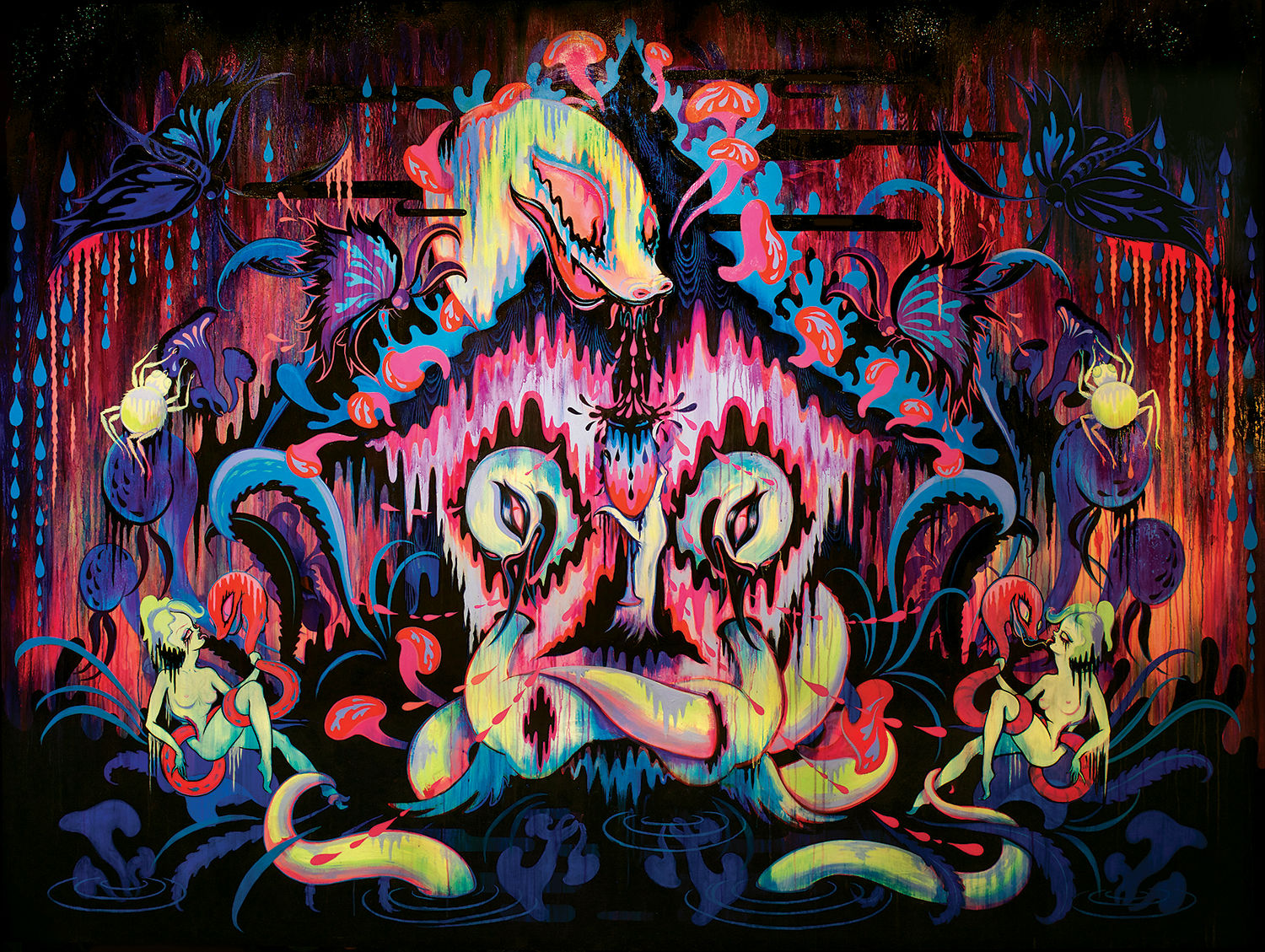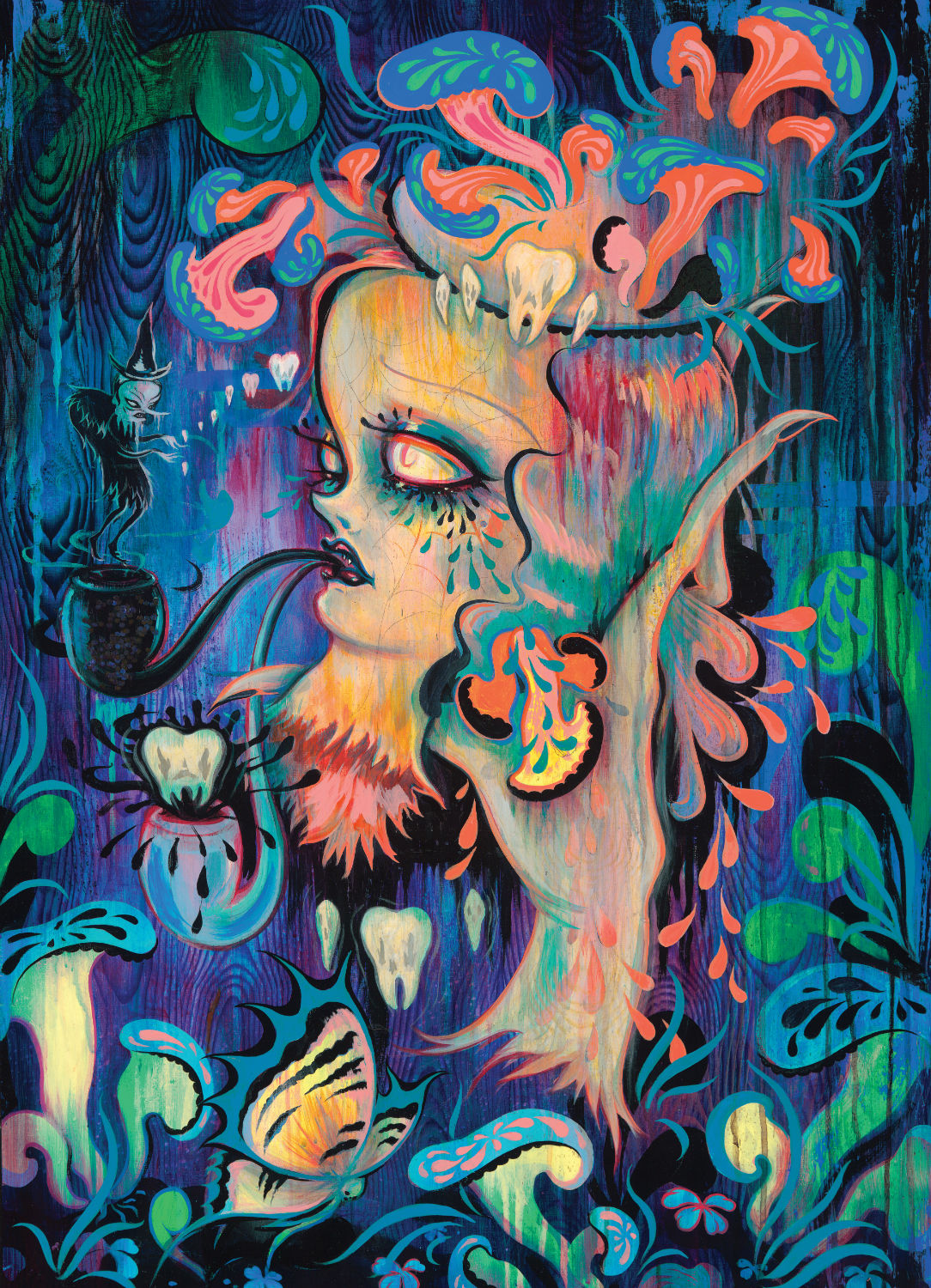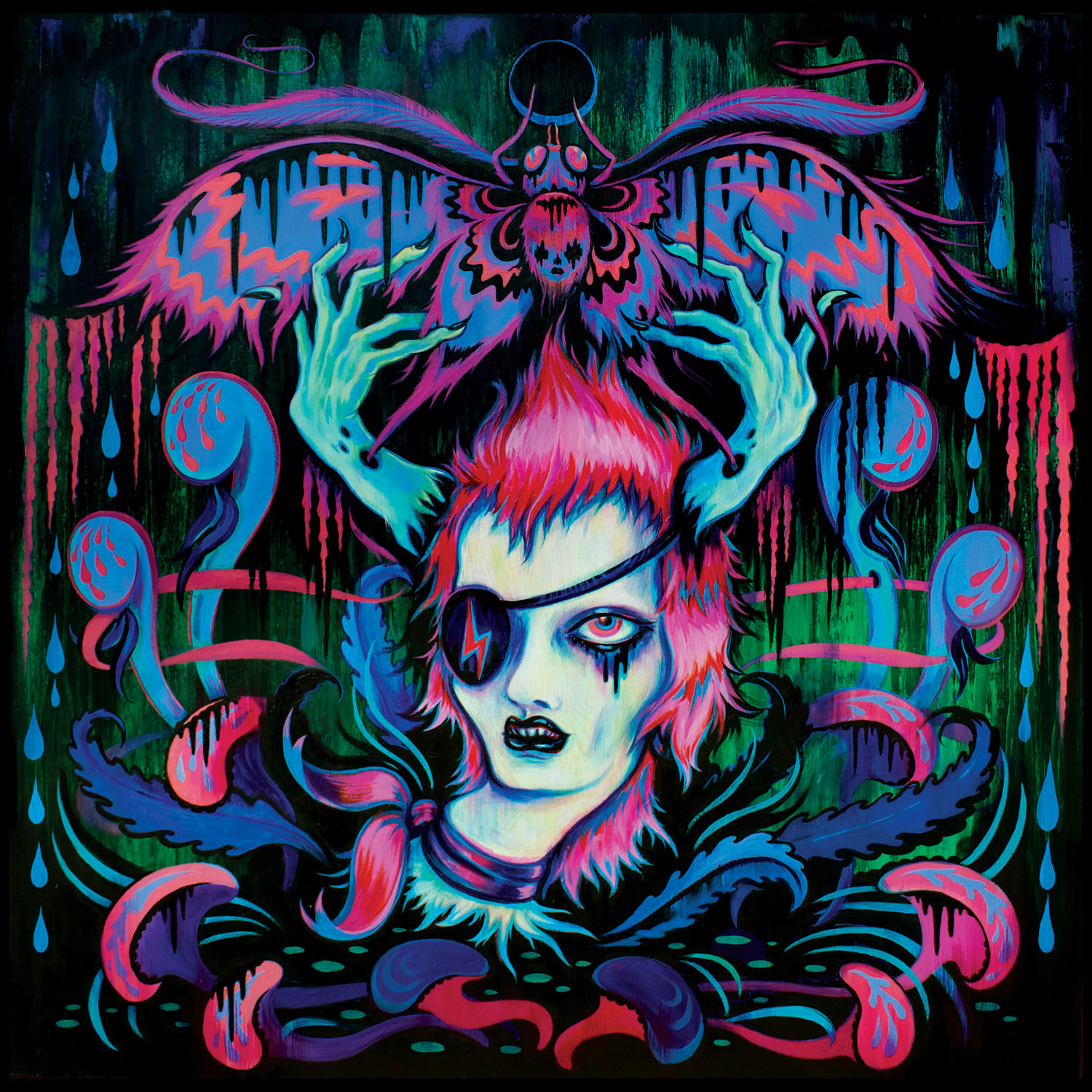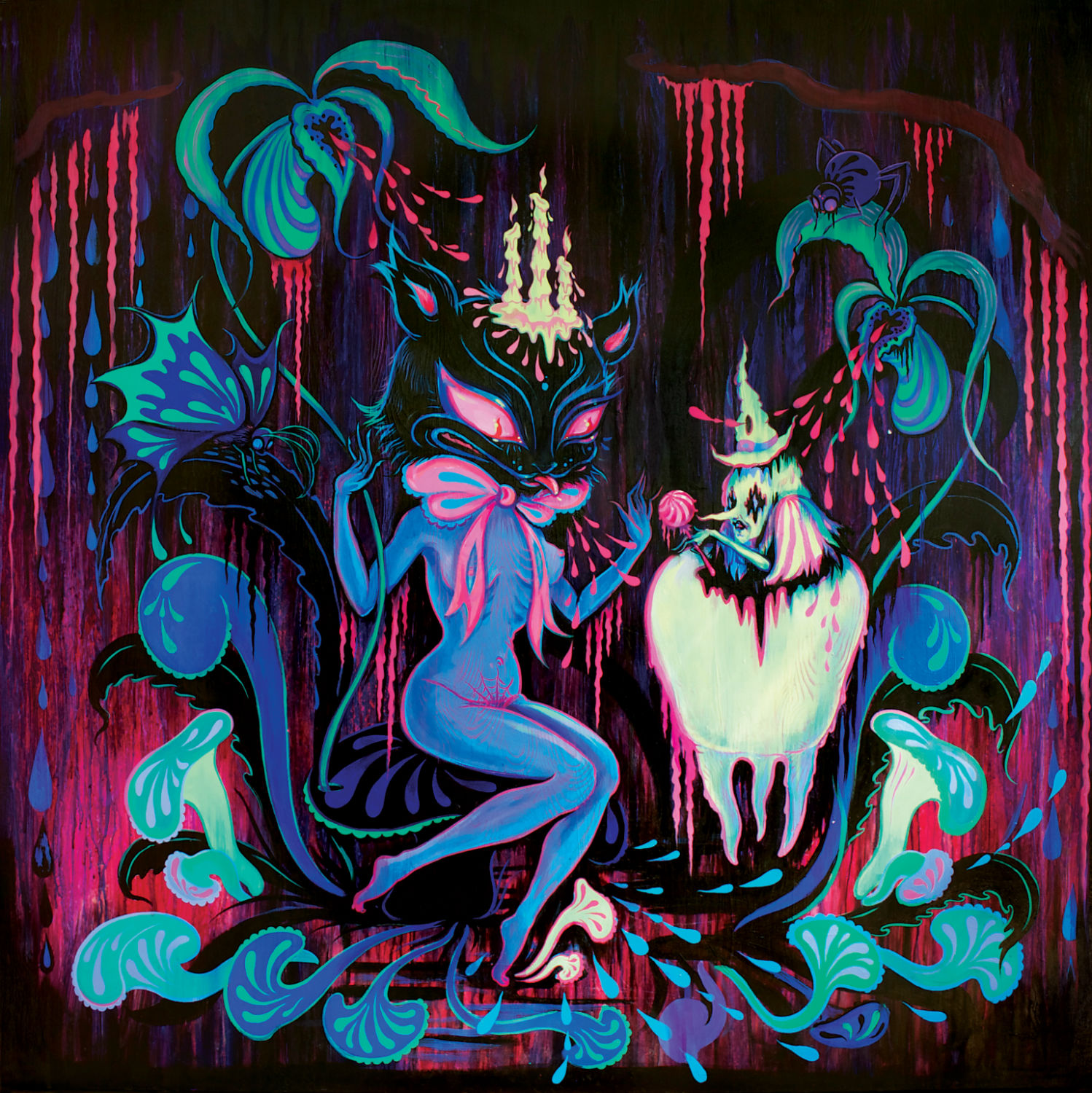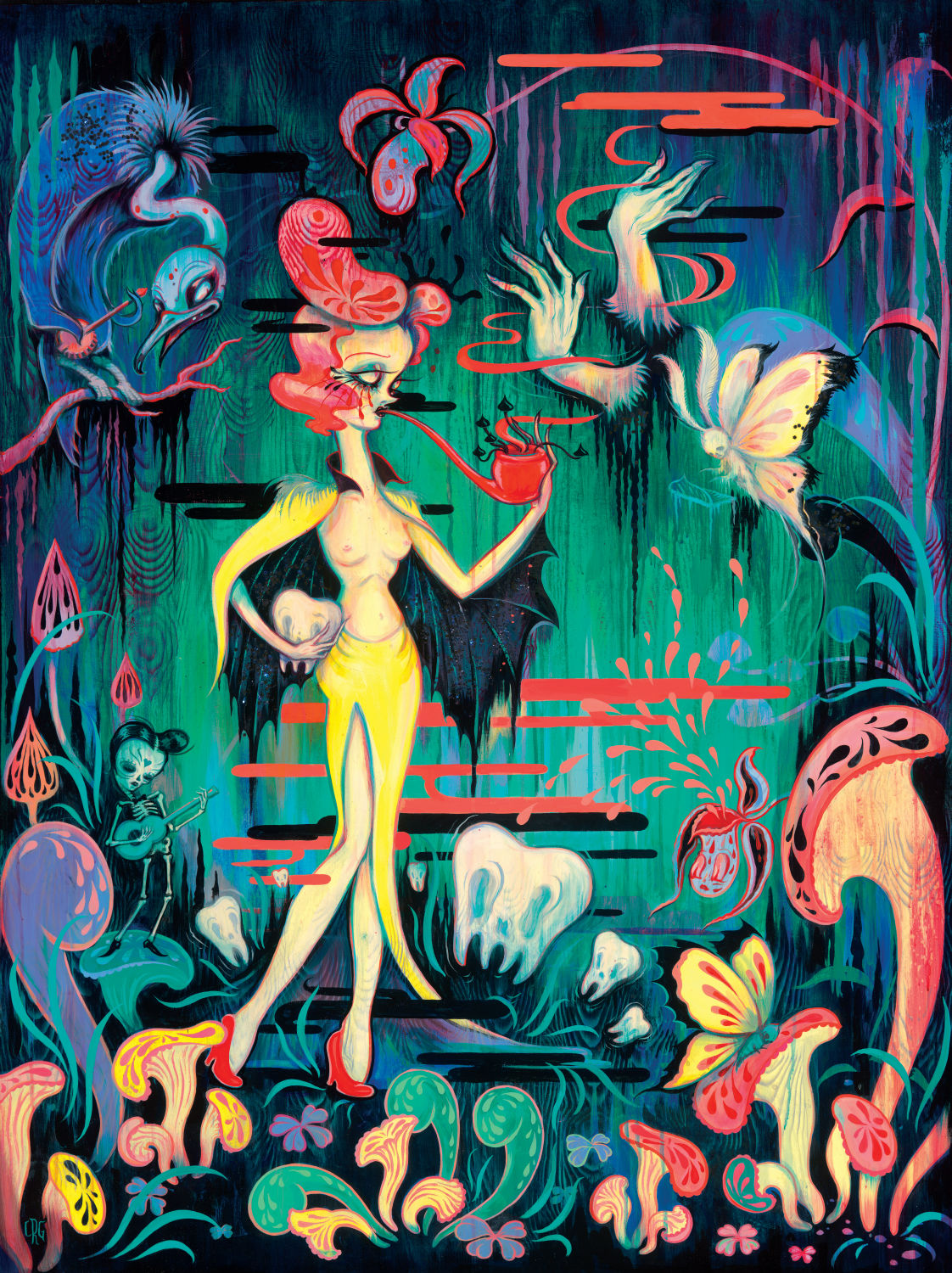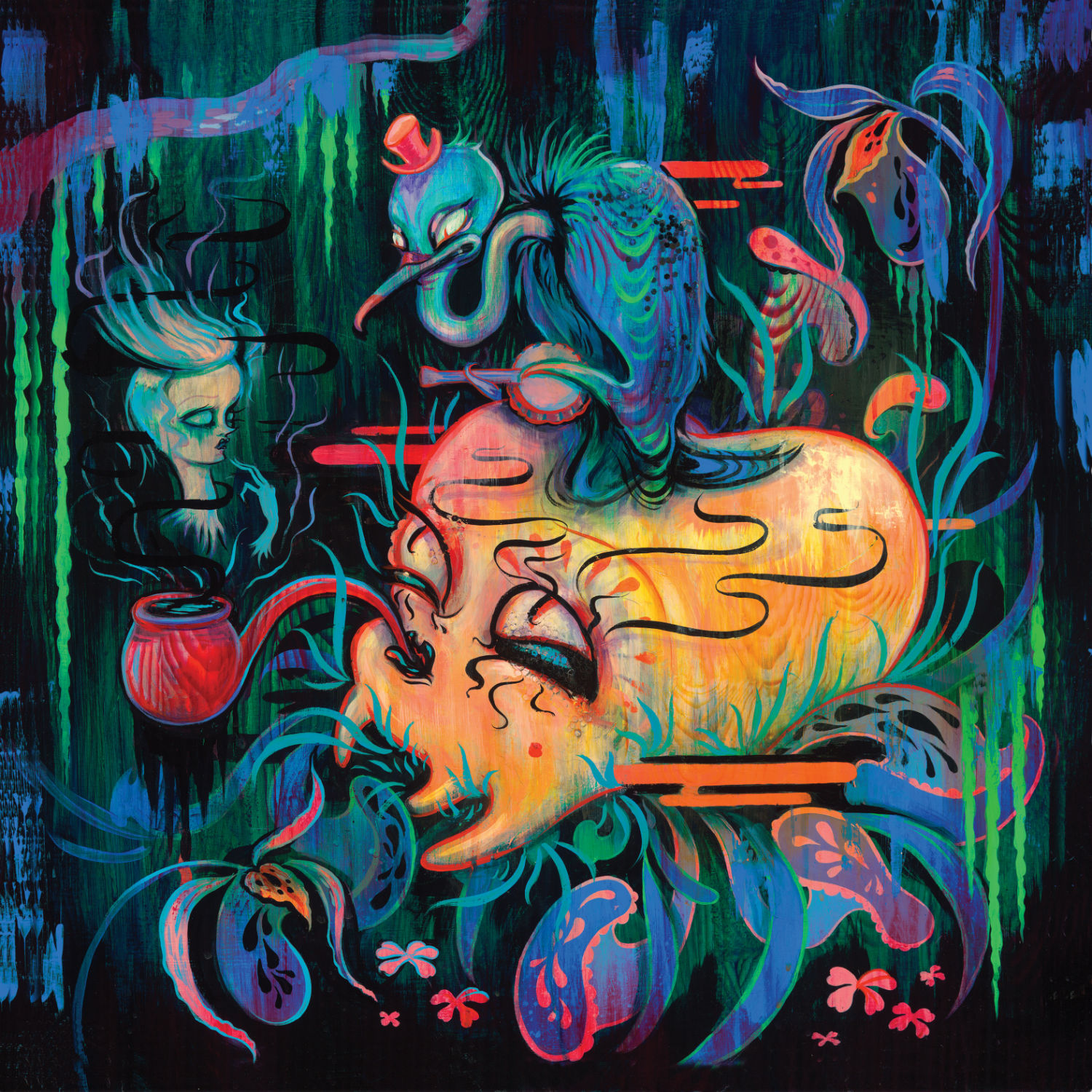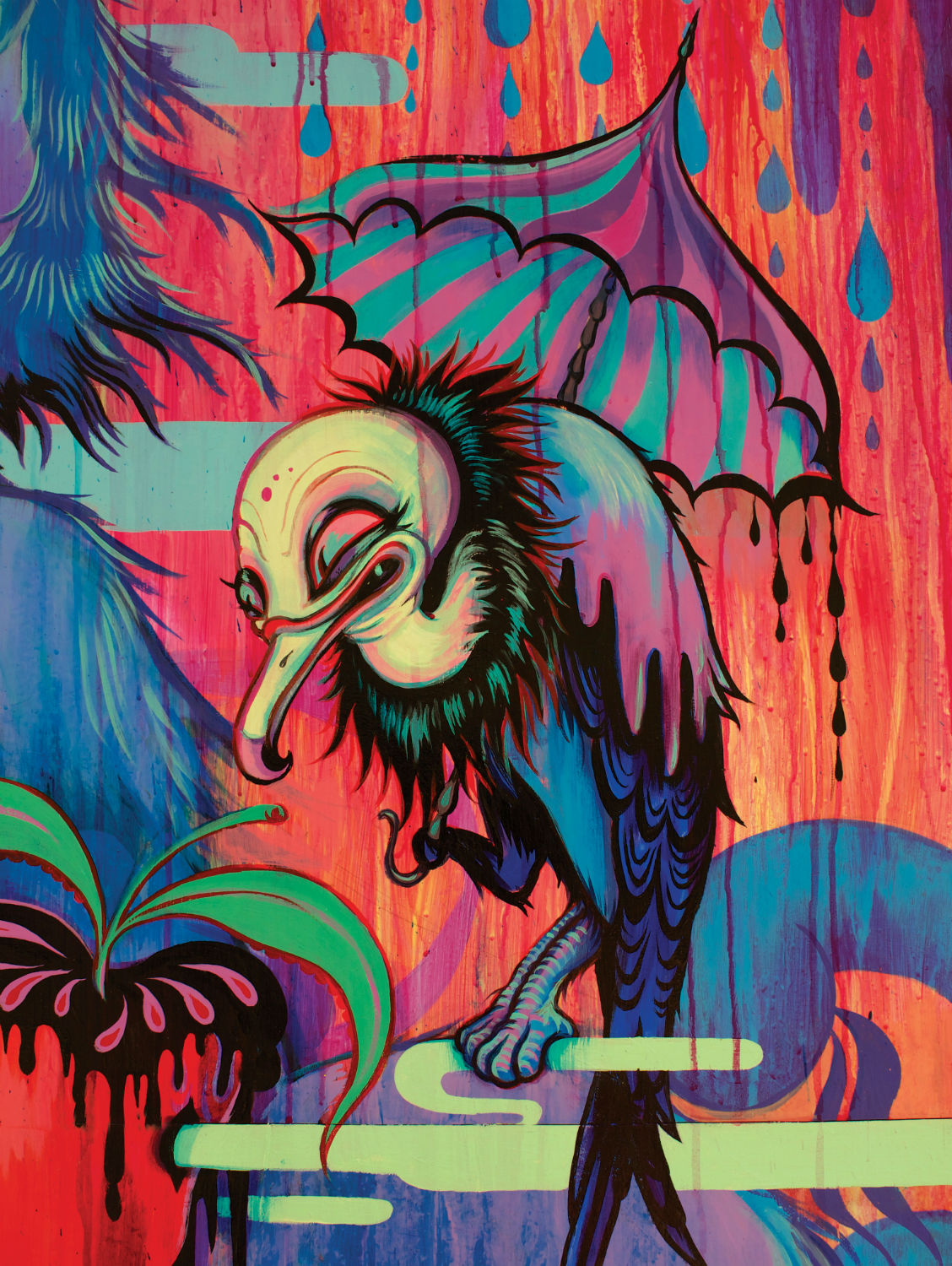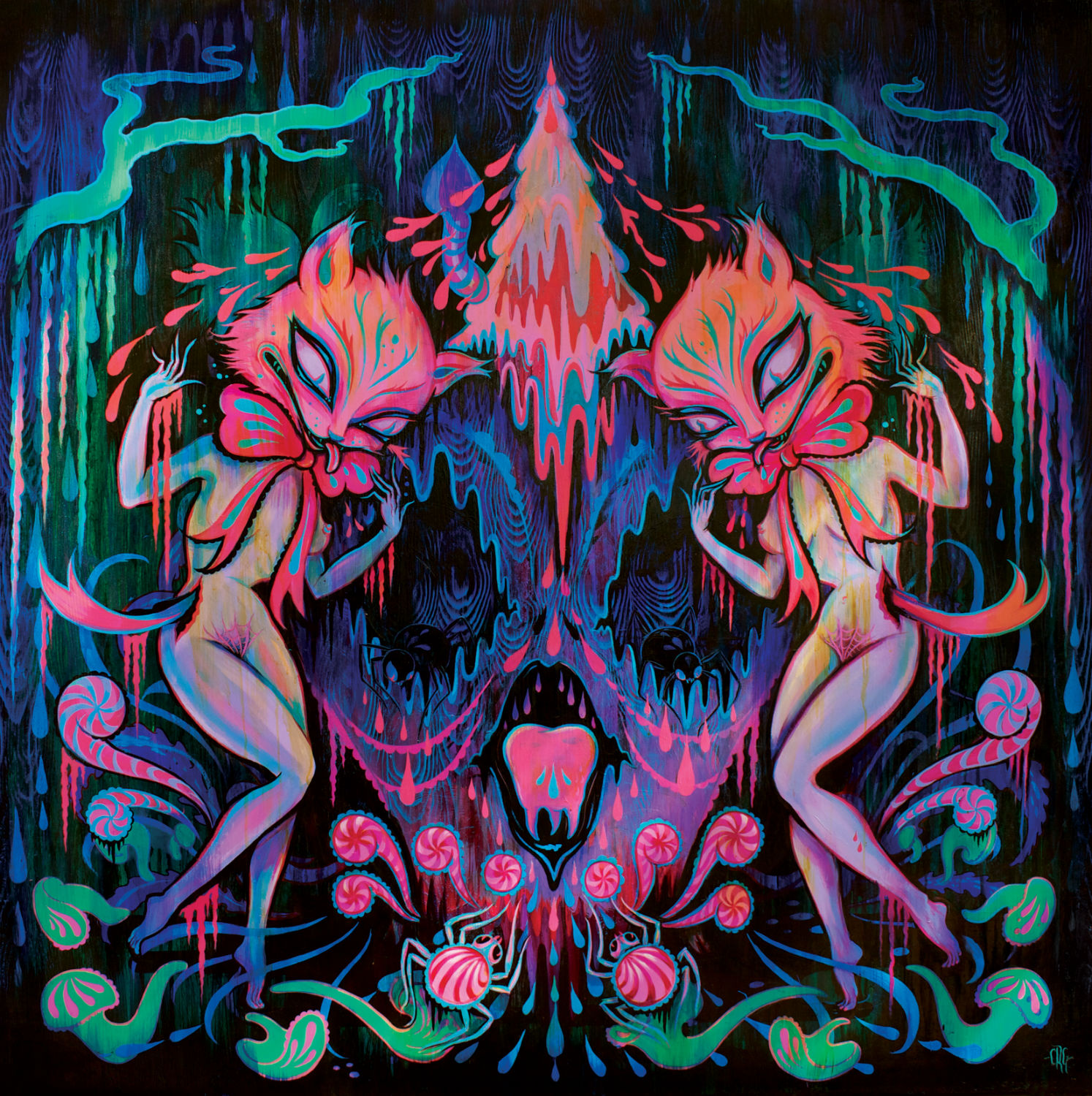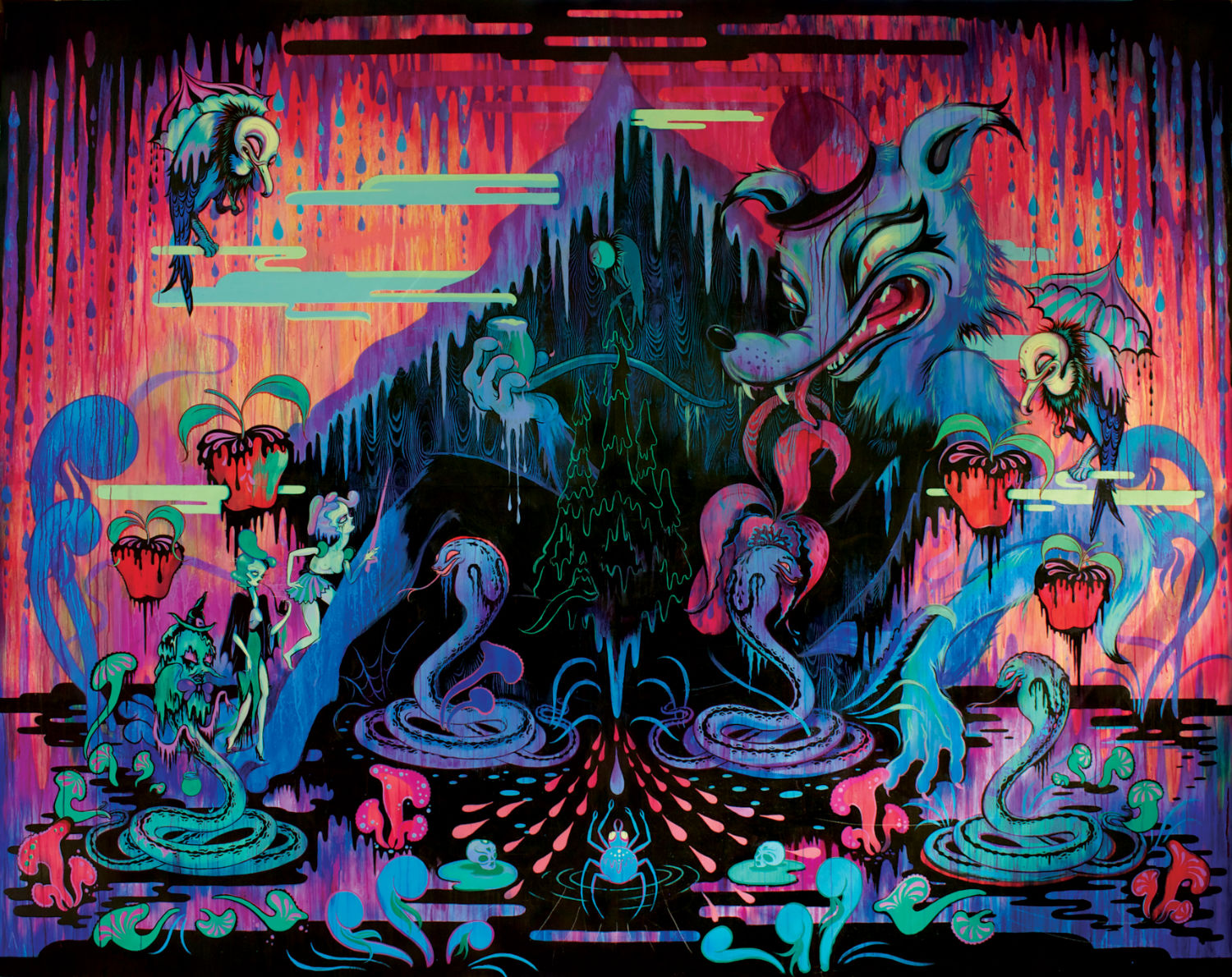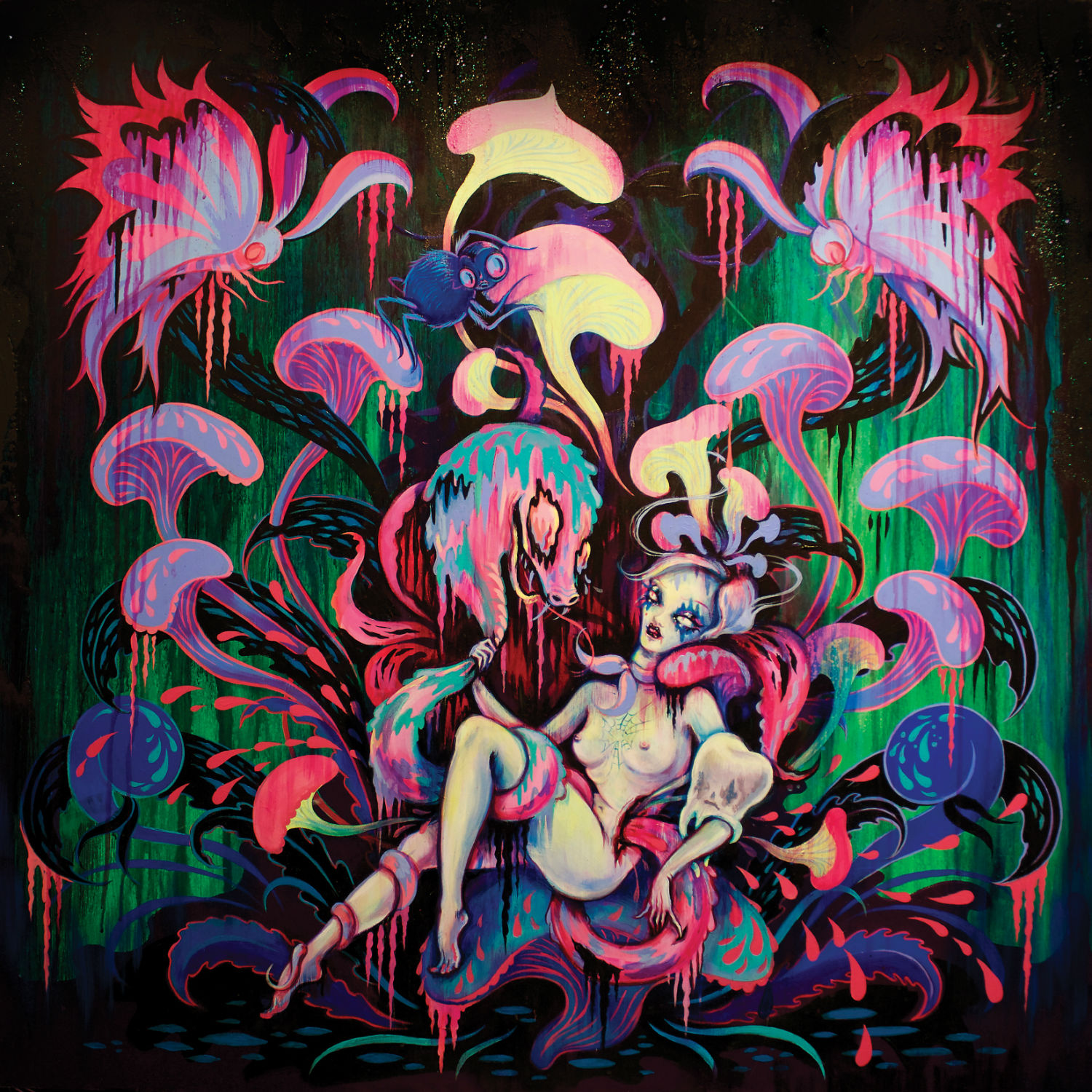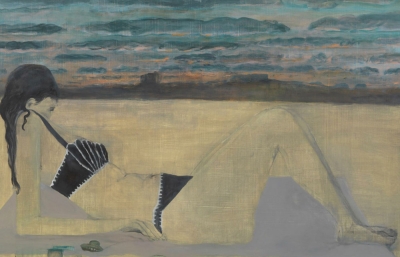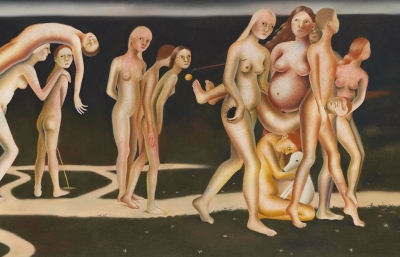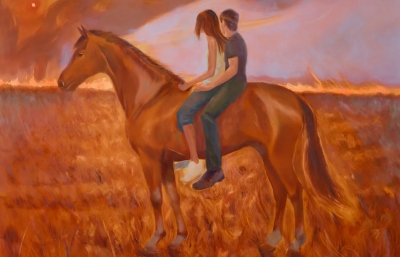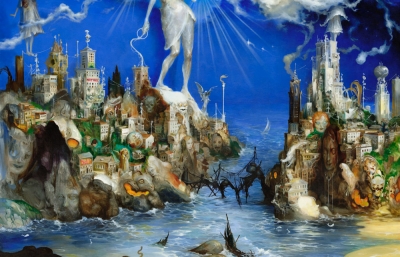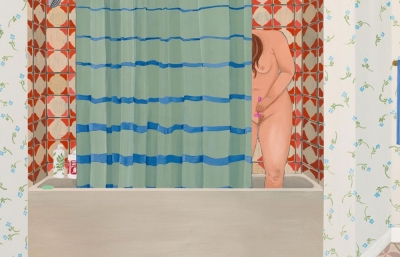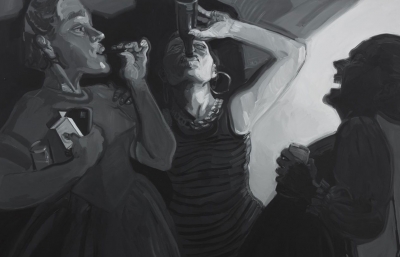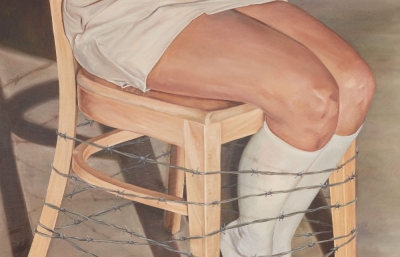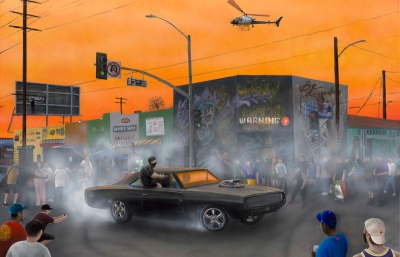A platter of mahogany brownies sits on the table, cut in perfect squares, the aroma inviting. How simple to pick one up and enjoy that honeyed, unctuous chocolate. But as that sweetness lolls around your mouth, the slow kindling fire of ancho chile warms its way inward and there’s more bite to the bite!
That Camille Rose Garcia, she’s a clever cook, the mistress of bitter and sweet. Sloe-eyed maidens and kitties cavort, birds prey and pray. Like Snow White’s apple, sugar and symmetry might transport you to another state of mind, might disclose thorns among roses, pollution in the babbling brook. Mother Nature’s valerian might transport you to Camille’s own magic kingdom.
Read the full feature in the September 2016 issue of Juxtapoz Magazine.
Gwynned Vitello: When I moved to a smaller house, I didn’t know where to put all my books. I ended up boxing most of them, but did find space in the shelves for the so-called children’s titles. Would you have made the same choice?
Camille Rose Garcia: This is a poignant first question. When I was around six or seven, I was an avid collector of illustrated children’s books. We had to move and my mom was out of town. The person that moved us ended up throwing out my entire book collection, and I remember, even at a young age, wanting to enact a great revenge. I felt like my life was over. I think I’ve been collecting children’s books ever since.
Have you always had the capacity to remember dreams in narrative form, not to mention, in color, and do you really draw from that ability?
I have always lived a bit too deeply in my dreamworld. Sometimes it’s hard for me to define any difference between a dream, a daydream, and actual reality. When it all becomes just part of memory, it blurs together, and in this way, I think my life is stranger as a whole than it might appear to a casual observer.
The paintings that I make often are trying to reflect the way I remember a dream. Full of layered symbols, not always a tangible solid atmosphere, and telling me something that I might not really understand at first. I feel like this is the language of the subconscious. This is very ancient, and we as a species need to really start listening. This might require withdrawing from the reality created by modern civilization, which wants to keep humans splashing around in the shallows of our minds like toddlers. If we are to evolve, we need to listen to a more ancient language.

Portrait by David Broach
Being the child of artist parents, maybe being creative has always been a way of life for you. That has to infuse a child with the impetus, or even the confidence, to make visual art.
I do feel very lucky that both my parents were creative in their careers. I grew up mainly with my mom, who was a single mother and a muralist and sign painter. I was drawing from the time I could talk, and that’s what I spent most of my time doing. I was pretty obsessed with cartoons and animation, I was fascinated with the idea of drawn pictures moving and coming alive. My father was a filmmaker, and I think that sense of narrative, of storytelling, comes directly from him. When I was around six or seven, we lived with my mom’s boyfriend who was an extremely abusive alcoholic. That’s really when I absolutely used my imagination for survival purposes. I would create entire worlds to inhabit in order to escape the one I was actually in.
I think this is why I find the writing of Philip K. Dick so compelling. He a depicts these parallel universes, worlds within worlds, and the characters are always escaping from one world into the other.
Legend has it that you lived a block away from Disneyland. For most of us, it was, at most, a once-a-year visit with the family. Did you have a routine, and what was your favorite ride? Obviously, you must’ve been a Fantasyland frequenter?
Well, it was a couple of miles actually, but yeah, at the time, if you were local, you could go after 4:00 pm for, like, six dollars! I was already completely obsessed with the classic Disney animations, Snow White, Pinocchio, Bambi, and the idea of being fully immersed in that world was something I found completely captivating. It was like I was going to this wonderful land to visit all of my closest friends, that’s how I felt about it. I think I felt more a part of that world than the one outside of the Magic Kingdom. I needed that escape into such a world, which really helped me survive the terrible banality that exists in the suburbs.
My routine is still the same! I always head straight to Pirates of the Caribbean and the Haunted Mansion because they are next to each other, and I love to start the day with a pirate battle. Then the Jungle Boat cruise because I love the feeling of the boat on the water—and you are actually outside going down a river! It feels really relaxing. My two favorite rides from childhood are actually gone. Journey Through Inner Space was fantastic, and I actually believed they shrank me into a tiny person for the longest time. The original Submarine Voyage I loved because, of course, the Giant Squid.
There’s a theory that creatives need time off to really get to the business of being creative, maybe doing something completely different than the usual day to day. Do you feel that you need a change of venue?
Absolutely. I really enjoy playing music when I’m not painting. I play guitar and bass, and not having pressure involved for it to be that good allows it to feel very liberating. There’s something about the pressure of having to be great that really can inhibit any creative risk-taking, so I think it’s important to remember the pure joy of creating something while trying not to overthink it too much.
I also spend a lot of time in nature, hiking and swimming. That’s actually the best for creativity, to be able to relax the mind.

Does living deep in the redwoods, as opposed to life on the 405 and Santa Monica freeways, affect your creative process? Do you think someone just starting out needs the fellowship and feedback that comes with being in art school or part of the gallery scene?
Yeah, I still miss that camaraderie and feedback of my LA friends, who are all amazing creative people. I think it’s really, really important as a young artist to find your creative community, your tribe. It’s too hard to just be an isolated hermit. I love the people I know in Los Angeles, but I find the act of just getting around the city has become extremely oppressive, stress inducing, and anti-creative. The mind has to be relaxed to come up with good ideas, so for me, it’s become easier now to just visit. I love living immersed in nature, but it does sometimes get a bit lonely.
How did you get your first exhibit, and how was the experience? Do you approach and enjoy them differently these days?
My first solo exhibit was at Merry Karnowsky Gallery in 1999, but I had actually given up on the art world prior to that. I graduated in 1994, and struggled with poverty and just trying to survive, so I actually put art-making on the back burner for awhile. It was only after I didn’t give a fuck about making it in the art world that I had any success at all. That’s why I don’t put too much importance on whether or not anyone is paying attention to what I do, because I can’t really control those things.
I am always humbled and grateful to be able to have an exhibition, to be interviewed. It’s a great feeling to know that people care about what I do, and I am just still very lucky that I can do this as a career. There have been some shaky years lately, where I would think, this is crazy, I should get a normal job with a paycheck.
Do you keep sketchbooks, and are they special to you? Do you have a certain size or type of paper that you prefer?
I love keeping sketchbooks, and I have kept all of them in the archives, some I even have from high school! I like a sturdy watercolor paper, I hate flimsy paper. And the size I like is maybe an 11 x 17”. I’ve tried smaller, more portable sizes, but I actually don’t like to draw around people, so there’s no reason to carry it in my bag. My favorite sketchbooks are the Holbein series, made in Japan. They have a spiral binding and cloth ties, and the paper is perfect.
Why aren’t you comfortable drawing in front of an audience? Is this common with artists?
I feel like it becomes more of a performance rather than an exploration inward. There’s also an expectation, especially at signings with the long line of people all watching, to draw quickly and perfectly. My quick sketches are usually kind of sloppy and not really intended to be a permanent part of someone’s book. So I end up feeling badly, as there is an expectation. It’s so pressured, it just doesn’t turn out to be enjoyable. I know Mark Ryden doesn’t like to draw in front of people either. So I’m sure I’m not alone! I even have a hard time having an assistant in the studio, or anyone helping me, as I feel like even a simple question will pull me out of my imagination, back into the tangible world. Like writing, it’s such a solitary pursuit for me.

Is it possible to describe how you make a painting and how long it takes? I know you start with your sketches, and are they then guided by color, theme—or one of your dreams?
It’s quite a process. Usually I start with writing about themes I’m interested in exploring. Then I kind of choose a palette of symbols and characters to use for the paintings. Then I do a ton of sketches. I have piles and piles of sketches by the end of things, and I’ll start to put together the layouts of the paintings. But sometimes these change drastically in the process, so I don’t get too attached to the pre-sketch. The color palette really comes last, after everything else is figured out.
I usually work on one series of paintings at a time, and I often have 10 or 15 started. I like it when one informs the other, so they start working together like a band. They really take on a life of their own and start communicating, and I’m just like the orchestrator or something! I hate working on just one, if feels lonely and sad. As for how long they take, that’s kind of unquantifiable! They take all of my life, all of the hours.
Because he’s often cited as one of your favorite writers, I looked up William Burroughs and laughed in spite of his quote that said, “After one look at the planet, any visitor from outer space would say, I want to see the manager.” You’ve been a voice for the environment your whole career. Will that always be a theme in your work?
Yes, the main theme of my work is our relationship as humans to nature. I really feel like something has been lost as humans, that we lost that connection and it’s destroying us. We have to stop thinking of ourselves as separate from nature. That kind of thinking is suicidal.
Tell us about your show opening at Corey Helford and any new projects you have coming up.
I’m really excited about my show, Phantasmacabre, at Corey Helford Gallery! These are some of the largest paintings I have done, and I really enjoy working on a larger scale. I like the feeling of a viewer being totally immersed in the painting, taken over by it.
This is also the most personal work I have done. I’m using a language of fairytale symbols to tell a personal story, one of battling inner demons and ghosts. I’m also abstracting the pictorial space a bit by using repetition and symmetry. It kind of puts you in a weird trance looking at it.
I’m also really excited about the book I wrote and illustrated, The Cabinet of Dr. Deekay. It’s a surrealist, dystopian tale that takes place in a hospital, and has elements of George Orwell, Aldous Huxley and Roald Dahl, three of my favorite writers. It was inspired by a terrible reaction to the drug Ativan, which I was given prior to having gum surgery. In this same week, I had 11 root canals done, and was scheduled for gum surgery on the Friday. They gave me this pill that sent me into a strange acid-trip amnesia hell. I had waking nightmares for weeks after.
This book is also being being developed as a stop-motion animation by the brilliant animator Martin Munier, who worked on Coraline and James and the Giant Peach. It’s really exciting to finally be working in an animated format. It’s been a lifelong dream of mine, and the story is exactly what I want it to be! I can’t wait to unleash it upon the world.
Camille Rose Garcia’s Phantasmacabre will be on view at Corey Helford Gallery in Los Angeles through August 20, 2016.
----
Orignally published in the September 2016 issue of Juxtapoz Magazine, available here.

